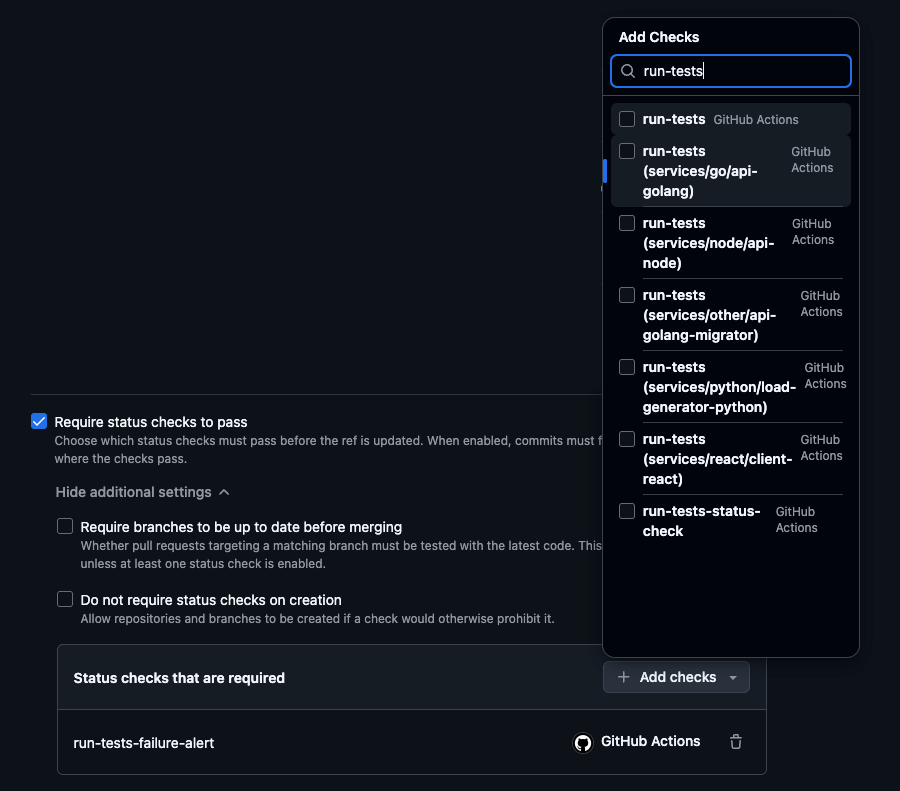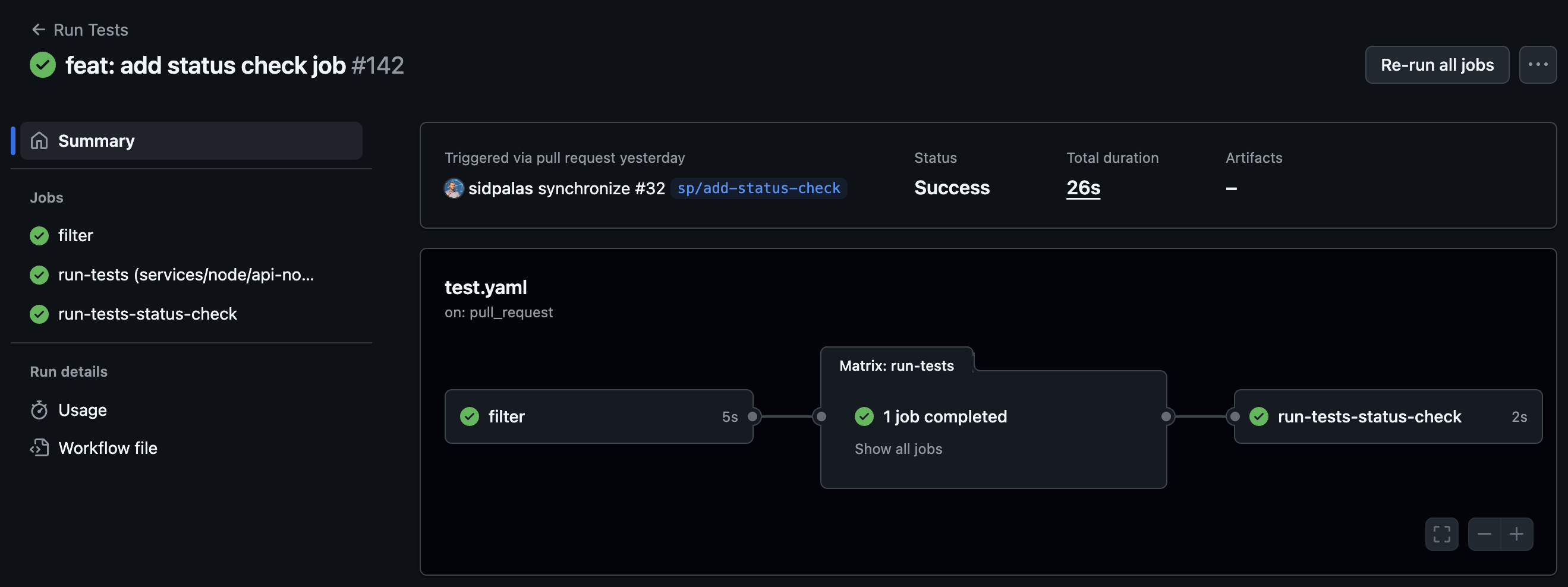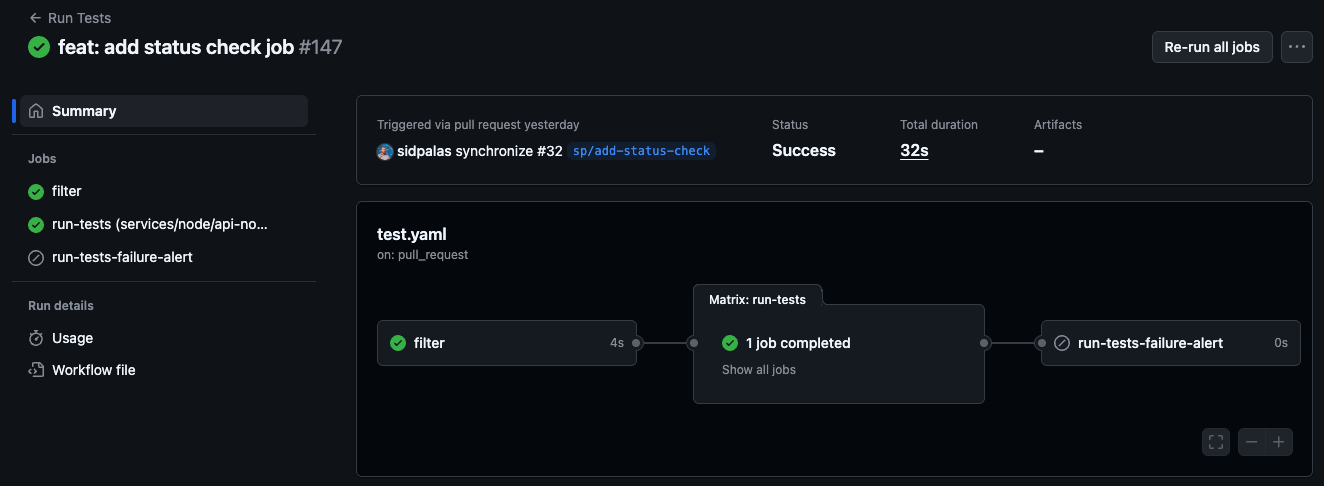GitHub Actions Required Checks for Conditional Jobs
GitHub has a feature called rulesets which allows you to define rulesets to control various behaviors within a repo.
One common use case for rulesets is to define required status checks which must pass before a PR can be merged into the default branch.
For standard workflows, this is pretty straightforward. You choose the GitHub Actions workflow step you want to validate, and select it. For a workflow with a conditional job, or one which uses a matrix strategy to fan out over a variety of configurations, things get more complex.
This article was written as part of my preparations for the upcoming "GitHub Actions: Beginner to Pro" course I am working on.
See: https://github.com/sidpalas/devops-directive-github-actions-course for more info!
For example, this repo conditionally runs tests for services based on which changed in the PR using a dynamic matrix (see: advanced-github-actions-matrix). For any given PR, from 0 to N run-tests steps will have executed and we want to validate any that ran passed.

Which step should I choose?! 😱
Before we continue it is also important to highlight the following (somewhat counterintuitive) behavior:
A job that is skipped will report its status as "Success". It will not prevent a pull request from merging, even if it is a required check.
This GitHub Issue contains lots of useful discussion about this behavior and how to work with/around it and was the inspiration for Option 3 below.
Option 1: Require ALL THE CHECKS!
We could select each of the run-tests steps as required.
As noted, if a check is skipped, it reports its status as "success", so this would work for ensuring all checks that ran passed.
Pros:
- Does not require modifying the workflow
Cons:
- If a new services is added, you must remember to update the status checks
- The UI will have lots of required checks, many of which are skipped
Option 2: Add Downstream Check to Compile the Result
We could also add a job to the workflow which depends on our dynamic matrix but runs even if it fails or is skipped by specifying job.<job_id>.if: always():
run-tests-status-check:
runs-on: ubuntu-24.04
if: always()
needs: [filter, run-tests]
steps:
- name: Run Tests Status Check
run: |
svcs='${{ needs.filter.outputs.services }}'
echo "services=${svcs}"
echo "run-tests.result=${{ needs.run-tests.result }}"
# If no services changed, treat as success (no tests to run)
if -z "$svcs" ; then
echo "No matching services changed; passing status check."
exit 0
fi
# Otherwise, require the matrix job to have succeeded
if [[ "${{ needs.run-tests.result }}" == "success" ]]; then
echo "All test matrix jobs passed."
exit 0
else
echo "::error One or more test matrix jobs failed or were cancelled."
exit 1
fi
We can then use this single status check as the required check for our workflow:

Pros:
- A single status check keeps PR UI clean
- Continues working with no modifications when adding services
Cons:
- Requires modifying the workflow
- Adds a few seconds to the critical path (even in the success case)
Option 3: Add Downstream Check Which Raises Failures
A third option is to take advantage of the "skipped = success" behavior and add a job which is skipped UNLESS the upstream jobs fail or are cancelled.
run-tests-failure-alert:
runs-on: ubuntu-latest
needs: [filter, run-tests]
if: ${{ cancelled() || contains(needs.*.result, 'cancelled') || contains(needs.*.result, 'failure') }}
steps:
- name: Conditionally Fail Required Check
shell: bash
run: |
echo "::error Some required job has failed!"
exit 1

Successful Run (failure alert step is skipped)

Failed Run (failure alert runs and fails)
Pros:
- A single status check keeps PR UI clean
- Continues working with no modifications when adding services
- Doesn't add time to the critical path in the success case
Cons:
- Requires modifying the workflow
- The
if: ${{ cancelled() || contains(needs.*.result, 'cancelled') || contains(needs.*.result, 'failure') }}is relatively complex - Relies on understanding the skipped = success behavior (job naming + comments can help)
Final Thoughts
The fact that option 1 requires remembering to make a manual update as services are added/removed makes it inherently unsafe.
In my opinion, options 2 & 3 are both reasonable approaches and choosing one over the other is a matter of personal preference. I like option 3 slightly more as implemented here because it avoids inline bash and doesn't extend the the critical path runtime.